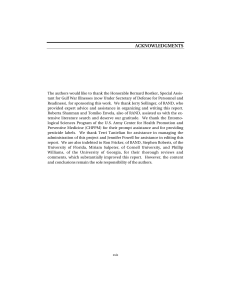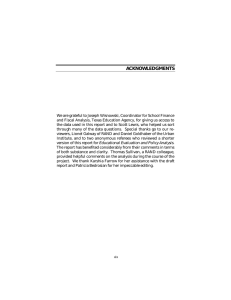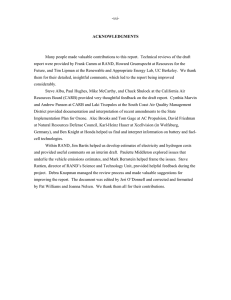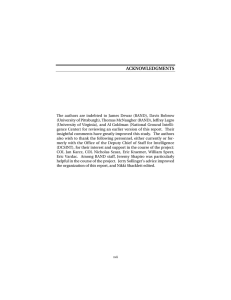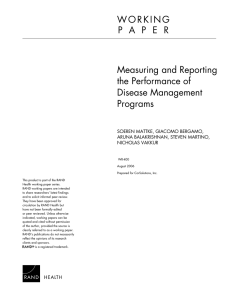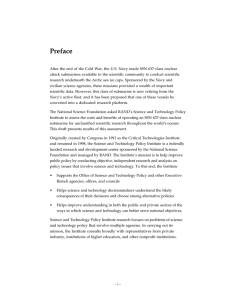A Sustaining Key Skills in the UK Naval Industry
advertisement
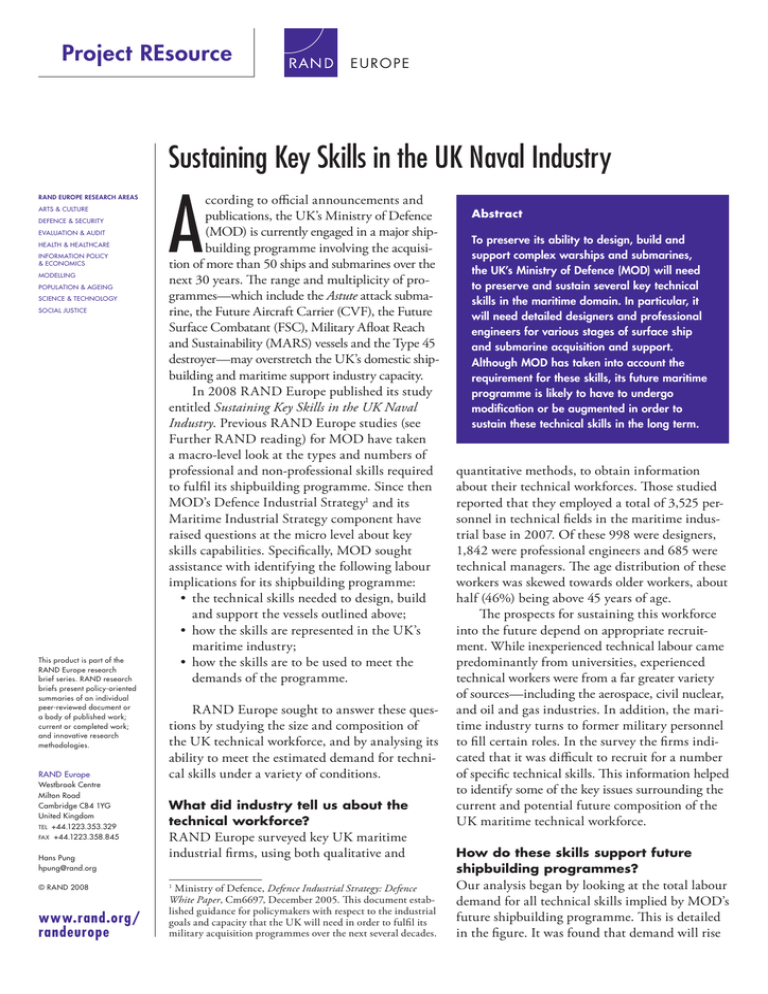
Project REsource EUR OPE Sustaining Key Skills in the UK Naval Industry RAND EUROPE RESEARCH AREAS ARTS & CULTURE DEFENCE & SECURITY EVALUATION & AUDIT HEALTH & HEALTHCARE INFORMATION POLICY & ECONOMICS MODELLING POPULATION & AGEING SCIENCE & TECHNOLOGY SOCIAL JUSTICE This product is part of the RAND Europe research brief series. RAND research briefs present policy-oriented summaries of an individual peer-reviewed document or a body of published work; current or completed work; and innovative research methodologies. RAND Europe Westbrook Centre Milton Road Cambridge CB4 1YG United Kingdom TEL +44.1223.353.329 FAX +44.1223.358.845 Hans Pung hpung@rand.org © RAND 2008 www.rand.org/ randeurope A ccording to official announcements and publications, the UK’s Ministry of Defence (MOD) is currently engaged in a major shipbuilding programme involving the acquisition of more than 50 ships and submarines over the next 30 years. The range and multiplicity of programmes—which include the Astute attack submarine, the Future Aircraft Carrier (CVF), the Future Surface Combatant (FSC), Military Afloat Reach and Sustainability (MARS) vessels and the Type 45 destroyer—may overstretch the UK’s domestic shipbuilding and maritime support industry capacity. In 2008 RAND Europe published its study entitled Sustaining Key Skills in the UK Naval Industry. Previous RAND Europe studies (see Further RAND reading) for MOD have taken a macro-level look at the types and numbers of professional and non-professional skills required to fulfil its shipbuilding programme. Since then MOD’s Defence Industrial Strategy1 and its Maritime Industrial Strategy component have raised questions at the micro level about key skills capabilities. Specifically, MOD sought assistance with identifying the following labour implications for its shipbuilding programme: • the technical skills needed to design, build and support the vessels outlined above; • how the skills are represented in the UK’s maritime industry; • how the skills are to be used to meet the demands of the programme. RAND Europe sought to answer these questions by studying the size and composition of the UK technical workforce, and by analysing its ability to meet the estimated demand for technical skills under a variety of conditions. What did industry tell us about the technical workforce? RAND Europe surveyed key UK maritime industrial firms, using both qualitative and 1 Ministry of Defence, Defence Industrial Strategy: Defence White Paper, Cm6697, December 2005. This document established guidance for policymakers with respect to the industrial goals and capacity that the UK will need in order to fulfil its military acquisition programmes over the next several decades. Abstract To preserve its ability to design, build and support complex warships and submarines, the UK’s Ministry of Defence (MOD) will need to preserve and sustain several key technical skills in the maritime domain. In particular, it will need detailed designers and professional engineers for various stages of surface ship and submarine acquisition and support. Although MOD has taken into account the requirement for these skills, its future maritime programme is likely to have to undergo modification or be augmented in order to sustain these technical skills in the long term. quantitative methods, to obtain information about their technical workforces. Those studied reported that they employed a total of 3,525 personnel in technical fields in the maritime industrial base in 2007. Of these 998 were designers, 1,842 were professional engineers and 685 were technical managers. The age distribution of these workers was skewed towards older workers, about half (46%) being above 45 years of age. The prospects for sustaining this workforce into the future depend on appropriate recruitment. While inexperienced technical labour came predominantly from universities, experienced technical workers were from a far greater variety of sources—including the aerospace, civil nuclear, and oil and gas industries. In addition, the maritime industry turns to former military personnel to fill certain roles. In the survey the firms indicated that it was difficult to recruit for a number of specific technical skills. This information helped to identify some of the key issues surrounding the current and potential future composition of the UK maritime technical workforce. How do these skills support future shipbuilding programmes? Our analysis began by looking at the total labour demand for all technical skills implied by MOD’s future shipbuilding programme. This is detailed in the figure. It was found that demand will rise Total technical workforce demand by ship class 2,500 Non-MOD 2,000 Workers steeply until 2013, reaching a level that will be twice the long-term average demand. Demand created by the complex surface ship programme is dominated by CVF in the short term, decreasing considerably in the long term. The submarine programme places a more constant demand, though that demand varies over time. After looking at labour demand at the aggregate level, we looked at demand for specific technical skills. Our analysis looked at labour demand at a variety of levels (total labour, technical labour, detailed design/professional engineer, and individual skills). This revealed various trends that allowed those making decisions about the future shipbuilding programme to better understand how the availability of technical skills may affect the maritime industry. For example, we found that MOD’s complex warship programme will produce an initial peak in demand for professional engineer skills, followed by a trough as the carrier programme winds down and the final hulls for the Type 45 programme are completed. We also found that for the submarine sector, the CVF programme could act as a vital bridge, providing demand both for submarine detailed designers and for professional engineering skills prior to the start of the Successor new design. MARS 1,500 FSC MUFC 1,000 CVF Type 45 500 Successor Astute 0 2007 2011 2015 2019 2023 2027 NOTE: Successor is the UK’s next generation nuclear deterrent submarine; MUFC stands for Maritime Underwater Future Capability. • Detailed designers are in most demand during the design process for first-of-class ships and submarines. Professional engineers are involved more equally across the design and build processes. • Recruiting certain technical skill sets will be challenging for the industry. Specifically, these relate to experienced professional engineers who are naval architects, electrical (power) engineers, systems engineers and mechanical engineers. • The technical skills needed today may not be needed in the future. Industry anticipates an increased requirement for information technology skills and electrical engineers. Working practices are also forecast to change—leading to, for example, greater remote working and a need for wider language skills. ■ What policy conclusions can the Ministry of Defence draw from the findings? Some general trends emerge from this analysis with regard to the future demand for design and engineering technical skills in the submarine and surface ship sectors: • The MOD baseline programme will need some modification to help sustain the technical skills to support key industrial capabilities. • Overall there is sufficient demand from the submarine programmes to sustain design and build technical skills until 2027. Beyond this the situation is less clear. • The complex surface ship sector is more fragile than the submarine base with regard to technical skills. Further RAND reading: Hans Pung, Laurence Smallman, Mark V. Arena, James G. Kallimani, Gordon T. Lee, Samir Puri, John F. Schank, Sustaining Key Skills in the UK Naval Industry, Santa Monica, Calif.: RAND Corporation, MG-725-MOD, 2008. As of May 2008: http://www.rand.org/pubs/monographs/MG725/ John F. Schank, Mark V. Arena, Paul DeLuca, Jessie Riposo, Kimberly Curry, Todd Weeks, James Chiesa, Sustaining U.S. nuclear submarine design capabilities, Santa Monica, Calif.: RAND Corporation, MG-608-NAVY, 2007. As of May 2008: http://www.rand.org/pubs/monographs/MG608.1/ Mark V. Arena, Hans Pung, Cynthia R. Cook, Jefferson P. Marquis, Jessie Riposo, Gordon T. Lee, The United Kingdom’s naval shipbuilding industrial base: the next fifteen years, Santa Monica, Calif.: RAND Corporation, MG-294-MOD, 2005. As of May 2008: http://www.rand.org/pubs/monographs/MG294/ RAND Europe is a not-for-profit research organisation providing objective analysis and effective solutions that address the challenges facing the public and private sectors around the world. RAND Europe’s publications do not necessarily reflect the opinions of its research clients and sponsors. R® is a registered trademark. RAND Offices Santa Monica, CA • Washington, DC • Pittsburgh, PA • Jackson, MS/New Orleans, LA • Doha, QA • Cambridge, UK • Brussels, BE RB-9349-RE (2008) THE ARTS CHILD POLICY CIVIL JUSTICE This PDF document was made available from www.rand.org as a public service of the RAND Corporation. EDUCATION ENERGY AND ENVIRONMENT HEALTH AND HEALTH CARE INTERNATIONAL AFFAIRS NATIONAL SECURITY POPULATION AND AGING This product is part of the RAND Corporation research brief series. RAND research briefs present policy-oriented summaries of individual published, peerreviewed documents or of a body of published work. PUBLIC SAFETY SCIENCE AND TECHNOLOGY SUBSTANCE ABUSE TERRORISM AND HOMELAND SECURITY TRANSPORTATION AND INFRASTRUCTURE The RAND Corporation is a nonprofit research organization providing objective analysis and effective solutions that address the challenges facing the public and private sectors around the world. WORKFORCE AND WORKPLACE Support RAND Browse Books & Publications Make a charitable contribution For More Information Visit RAND at www.rand.org Explore RAND Europe View document details Limited Electronic Distribution Rights This document and trademark(s) contained herein are protected by law as indicated in a notice appearing later in this work. This electronic representation of RAND intellectual property is provided for noncommercial use only. Unauthorized posting of RAND PDFs to a non-RAND Web site is prohibited. RAND PDFs are protected under copyright law. Permission is required from RAND to reproduce, or reuse in another form, any of our research documents for commercial use. For information on reprint and linking permissions, please see RAND Permissions.
